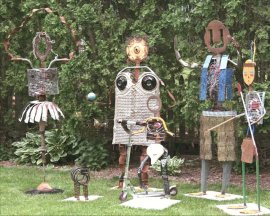 The use of found objects carries an up-front challenge to artists. Do you try to transform the identity of the "junk" by visually turning it into something else? Or do you accept the object (and all of its cultural baggage) for what it is and shape your artistic statement to incorporate the materials and their recognizability?
The use of found objects carries an up-front challenge to artists. Do you try to transform the identity of the "junk" by visually turning it into something else? Or do you accept the object (and all of its cultural baggage) for what it is and shape your artistic statement to incorporate the materials and their recognizability?
This was one of many issues faced by several local artists who participated in the Mississippi Palette project this year. The artists teamed up with the Artists Advisory Council, high-school and college students, environmentalist Chad Pregracke, and his Living Lands & Waters organization to create eight found-material sculptures.
Another challenge that comes with this project is placement of the work and its role in its new environment. In addition to fabricating the works, the artists had to secure a location for their installations. How will the sculpture "function" in its setting? Is it intended to blend in, or stand in ironic contrast to its surroundings?
Charles Knudsen IV and students from Davenport West High School built the soon-to-be-placed River People with numerous open spaces for birds to perch on and build their nests, for example. They are allowing the work to be both art and habitat, to become integral to its environment.
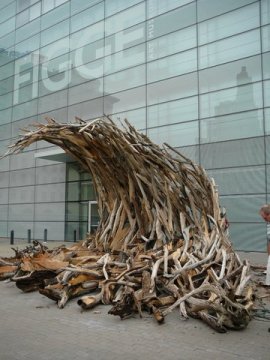 The lifespan of the work must also be considered. A piece made from biodegradable materials and placed in nature is a far different concern than one that is made from recyclable and non-recyclable materials and put in the same location. One can naturally deteriorate and be reclaimed by the Earth, while the other becomes a fancy layover for materials that should probably be returned to the landfill or recycling center.
The lifespan of the work must also be considered. A piece made from biodegradable materials and placed in nature is a far different concern than one that is made from recyclable and non-recyclable materials and put in the same location. One can naturally deteriorate and be reclaimed by the Earth, while the other becomes a fancy layover for materials that should probably be returned to the landfill or recycling center.
Immediately inside the front doors of the Figge Art Museum is the diptych River Relief by Heidi Moran Sallows and several students from Riverdale High School and Black Hawk College. This two-panel piece shows two figures bookending a compositional landscape populated with plastic bags, outlets, a deflated raft, bottles, Styrofoam, gloves, and other detritus. The Mississippi Palette catalog - available at the Figge's front desk - states that the component pieces are strung together "similar to a giant cross-stitch," so the sculpture can be disassembled and recycled at the end of its life.
Outside of the Figge stands Mark Fowler's and Chris Fennel's Wave. They, along with students from Moline High School, constructed an arching mass of interlocked pieces of driftwood. Passages of gnarled and twisting roots protrude in places, and some logs were planed down with a chainsaw to from irregular natural "boards." The piece takes on a darker hue after it rains, and several dry days later it returns to a bleached bone white.
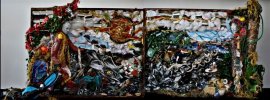 River Relief and Wave showcase the difference between emphasizing visual form and conceptual purpose. The works are merely a few feet away from each other physically, but they are miles apart in intent.
River Relief and Wave showcase the difference between emphasizing visual form and conceptual purpose. The works are merely a few feet away from each other physically, but they are miles apart in intent.
Wave is massive and ambitious, yet also elegant. The handling of the materials allows them to undergo a transformation and become a new visual experience. The wave itself is constructed out of hundreds of pieces of driftwood and lag bolts rising up and threatening to crash down. The piece succeeds because the underlying idea behind it is that you see a wave and not an organized pile of wood. The visual experience is the dominant concern.
In River Relief, on the other hand, the idea is paramount; the component pieces are only supposed to partially undergo a visual transformation. In this case, the found objects are used to create an image but also to illustrate how much crap is dumped back into the environment. Having you see figures in a landscape is fine, but it takes a backseat to the conceptual importance of what the materials are and where they came from.
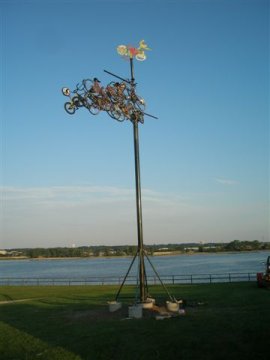 What Comes Around Goes Around, by Bill Wohlford and students from Pleasant Valley High School, is on the front side of the recycling center at 4403 Devils Glen Road in Bettendorf. It has six shopping carts evenly spaced on a hexagonal frame suspended between the apexes of two tire-rim pyramids. Each cart contains distinct and specific items to represent an aspect of how humans harm the environment; there is a cart "containing" automobile pollution, one for deforestation, one for littering, and so on.
What Comes Around Goes Around, by Bill Wohlford and students from Pleasant Valley High School, is on the front side of the recycling center at 4403 Devils Glen Road in Bettendorf. It has six shopping carts evenly spaced on a hexagonal frame suspended between the apexes of two tire-rim pyramids. Each cart contains distinct and specific items to represent an aspect of how humans harm the environment; there is a cart "containing" automobile pollution, one for deforestation, one for littering, and so on.
The piece has strong conceptual resonance because it plays many ideas against themselves. The tire rims encompass the cornucopia of automobile metaphors. Cars represent movement, affluence, power, joy, and freedom. They also suggest smog, gridlock, road rage, and increased carbon-dioxide levels. As a country and as a culture, we wouldn't be where we are today without the automobile. That last sentence has both positive and negative meanings.
Meanwhile, the "harmful" contents inside the carts come hand-in-hand with unbridled consumption, and in a perverse way we force ourselves to consume our own pollution.
A hearty walk from the Figge downstream along the bike path will deliver you to Amy Neilsen's towering Oooops. Nielsen, along with students from Davenport Central High School, created a large weather vane with a street sign and boat propeller at one end and a Frankenstein-ian assemblage of nearly a dozen bikes and a large arrow at the other end. The top is crowned with a cut sheet of a figure riding precariously on the front edge of an energized tumble of circles.
The weather vane responds to changes in wind direction, and a respectable gust can even turn the boat propeller. The street sign is a stop sign from the intersection of Locust and Pacific. As it sways in the wind, the sign - which used to designate a specific point - now enjoys an ironic freedom of whimsically scribing a circle in space.
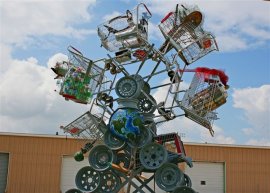 The arrow gives sad testament to kids' bikes being stolen, replaced, or lost, but they have found their ways to the river and are given one more chance to cut through the wind. The sheet-metal figure above the action of the weather vane functions as a comic-book thought bubble emanating from the bikes, a remembrance of happier times as the treasured chariots of exuberant youth.
The arrow gives sad testament to kids' bikes being stolen, replaced, or lost, but they have found their ways to the river and are given one more chance to cut through the wind. The sheet-metal figure above the action of the weather vane functions as a comic-book thought bubble emanating from the bikes, a remembrance of happier times as the treasured chariots of exuberant youth.
Oooops occupies an idyllic geographic crossroads of nature and commerce that speaks to what makes river towns so special. The sculpture is west of the boat ramp downstream from John O'Donnell Stadium, and you can hear river sounds and bird songs with highway and railroad noises in the background. Having spent my adolescence working on the river, it reminded me of sun-baked summers with Shad flies, the stink of cheap stale beer, and the rumbling of diesel engines.
The importance in placement of an outdoor sculpture cannot be ignored. The biomorphic shapes and tones of Wave stand in ironic contrast to the cool bluish-green and stark geometry of the Figge. The man-made forms within Oooops find a harmonious visual poetry with their surroundings. Neither work would be as powerful without its surroundings.
There are some breathtaking works to be seen in Mississippi Palette, and many would simply not exist if it were not for this project. Our local artists have proved that they can rise to the challenge for such an undertaking, but there simply aren't many opportunities or venues for works of this scale.
About Mississippi Palette
Mississippi Palette features sculptures from eight teams composed of lead artists and school groups. The lead artists were Mark Fowler and Chris Fennel; Charles T. Knudsen IV; Heidi Moran Sallows; Jeanne O'Melia; V. Skip Willits; Bill Wohlford; Dawn Wohlford-Metallo and Lisa Mahar; and Amy Nielsen.
These teams had to utilize materials routinely recovered from the river and its banks. The collaborative works can be found at Camanche High School, the Bettendorf recycling center, Rock Island High School, the River Drive bike path in Davenport, and the Figge Art Museum. One grouping has yet to be installed.
The pieces inside the museum are up through the end of August, and the piece outside of the museum is up through early fall. Several of the other works are up indefinitely.










